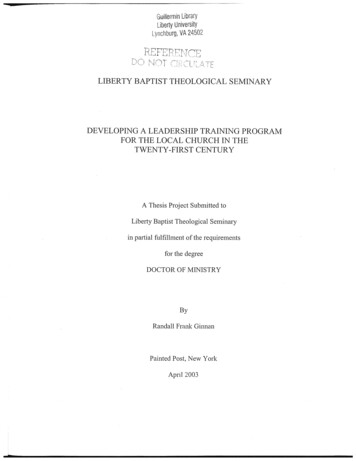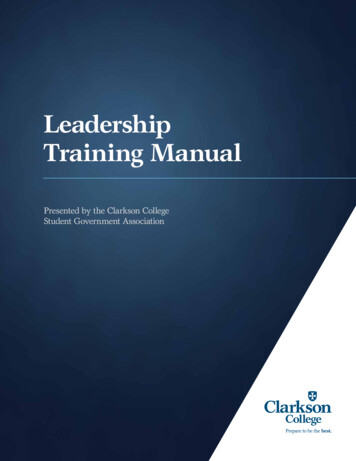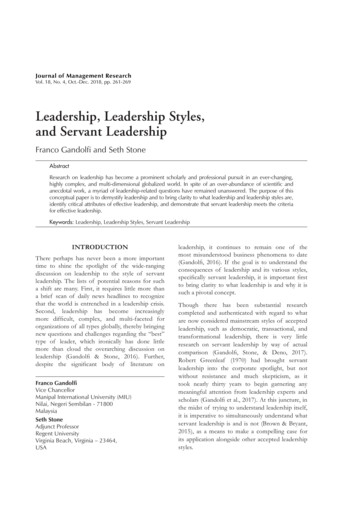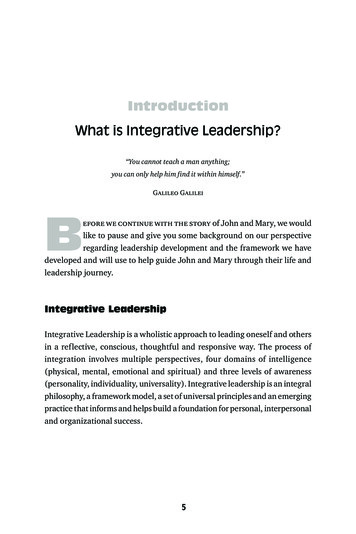
Transcription
Guillermin LibraryLiberty UniversityLynchburg, VA 24502LIBERTY BAPTIST THEOLOGICAL SEMINARYDEVELOPING A LEADERSHIP TRAINING PROGRAMFOR THE LOCAL CHURCH IN THETWENTY-FIRST CENTURYA Thesis Project Submitted toLibeliy Baptist Theological Seminaryin partial fulfillment of the requirementsfor the degreeDOCTOR OF MINISTRYByRandall Frank GilmanPainted Post, New YorkApn12003tr
LIBERTY BAPTIST THEOLOGICAL SEMINARYTHESIS PROJECT APPROVAL SHEETGRADEMENTORREADER
To my family and church for their sacrificeof time and unwavering support
The local church is the hope of the world and its future restsprimarily in the hands of its leadersBill Hybels, Courageous Leadership
CONTENTSLIST OF TABLES . ixABSTRACT . xChapters1. DEVELOPING A LEADERSHIP TRAINING PROGRAMFOR THE LOCAL CHURCH . 1Early Experiences . 1Rationale Why this Project Should be Done . 5The Statement of the Problem . 6The Statement of Limitation . 7The Theoretical Basis . 7The Statement of Methodology . 8The Review of the Literature . 12Sample QuestiOlmaires . 182. THE PRACTICAL AND BIBLICAL FOUNDATIONS FORLEADERSHIP TRAINING . 19 .,The Practical Foundation . 19The Biblical Foundation . 23Conclusion . 343. THEORIES OF LEADERSHIP DEVELOPMENT . 35Maximum Impact List Theories . 36Other training Theories . 49Conclusion . 554. LEADERSHIP STyLES . 56Leadership Styles Explored . 56Other Leadership Style Factors . 61Conclusion . 65VI
CONTENTS (Continued)5. THE DEFINITION OF LEADERSHIP . 66Management Verses Leadership . 67BOl11 Verses Made . 69Attitude Verses Action . 72Conclusion . 766. THE STRUCTURE OF LEADERSHIP TRAINING . 77Step 1: Identify the Purpose for the Training Program . 77Step 2: Detelmine What Type oftraining Program Best Fits the Organization . 79Step 3: Decide Which Training materials Will Be Used . 81Step 4: Provide Developmental Activities . 82Step 5: Determine the Program Specifics . 87Step 6: Align Structures to Reinforce the Program . 10'2Step 7: Evaluate the Leadership Training Program . 10'3Step 8: Plan for the Next Generation of Leaders . 10'5Conclusion7. AN EXAMPLE OF LEADERSHIP TRAINING . 10'6The Purpose .The Goals .The Program Activities .The Progralll Details .Year One Topics .Year Tvvo Topics .January Introduction Meeting .January Group Meeting .February Group Meeting .March Group Meeting .April Group Meeting .May Group Meeting .June Group Meeting .July Group Meeting .August Group Meeting .September Group Meeting .October Group Meeting .November Group Meeting .December Group Meeting 170'171176181186SUMMARY AND CONCLUSION . 187Vll
CONTENTS (Continued)AppendixA. PERFORMANCE EVALUATION PROCESS . 18 8B. DEVELOPMENTAL RELATIONSHIPS . 199C. LAWS OF LEADERSHIP . 203D. ENCYCLOPEDIA OF CHARACTER QUALITIES . 206E. LEADERSHIP STyLES . 210F. PROGRAM SURVEyS . 215G. LEADERSHIP RESOURCES . 220BIBLIOGRAPHy . 225Vlll
TABLESTablePage1. Skills That Define Leadership Capacities . 512. Management Functions Verses Leadership Functions . 683. Leadership is More Ali Than Science . 684. Four Categories of Leadership . 715. Characteristics of Admired Leaders . 736. Natural and Spiritual Leadership Characteristics . 747. Assessment of Current Leadership Qualities (For Potential Leaders) . 918. Program Specifics Worksheet . 100IX
ABSTRACTDEVELOPING A LEADERSHIP TRAINING PROGRAM FOR THELOCAL CHURCH IN THE TWENTY-FIRST CENTURYRandall F. GinnanLiberty Baptist Theological Seminary, 2003Mentor: Dr. Frank SchmittA review of the current literature demonstrates that there are a variety ofdefinitions of leadership, styles of leadership, and theories of leadership training. Thepurpose of this project is to review these definitions, styles and theories and propose astructure to develop that would be beneficial in constructing a leadership trainingprogram. This stmcture will then be utilized to develop an actual training program to beused by the North Baptist Church of Coming, New York.x
1DEVELOPING A LEADERSHIP TRAININGPROGRAM FOR THE LOCAL CHURCHAs this study begins it's exploration of the topic of developing a leadershiptraining program for the local church, several questions must be asked. Why is thisparticular project needed? Is it actually impOliant enough to study? What are the practicalimplications of conducting such a project? The answers for these questions come alive ina meaningful way as a look is taken at the personal experiences in the field ofleadershipand leadership development of a young pastor.Early ExperiencesEarly experiences can have a tremendous impact on the development of anindividual's understanding ofpatiicular areas. This young pastor encountered earlychurch experiences, early pasturing experiences, and experiences with pastors thataffected his thinking in the field oftraining leaders.Early Church ExperienceThis young pastor had been aware of and interested in leadership issues inside ofthe local church since he was in high school. Growing up in an evangelical Baptist1
2church, leadership issues were readily available for all to observe. In his earlyexperiences in church life he saw a leadership "tug-o-war" between the pastors and thelay leaders. This did not happen all the time, but on a very regular basis. Many of theissues being discussed, debated or fought over were not of a doctrinal nature, but for themost pati were more to do with how to approach leading the church. In many cases, as ateen, he observed that both sides, as well intentioned as they were, were lacking in basicleadership training or understanding.The pastors that he observed serving his church (he could recall eight of them)would be theologically trained and had a love for the Lord and His ministry. But, onmany occasions it was apparent that they led by position only. Because they were "thepastor" they felt that their leadership should be followed with no questions asked,whether or not they were making the right decision. I Unfortunately, often times they didnot possess the skill in dealing with boards, dealing with church issues or in dealing withchurch conflict. Many times their leadership did not seem to be leading in the correctdirection.On the other hand, he also remembered seeing church board members elected attimes for less than noble reasons. Some were asked to serve on the board because of howmuch they contributed to the church coffers, others were asked because it mightencourage them to be more faithful in church attendance, still others were asked becausethey held a position of influence in the community, and even others were asked to serveon the board because everyone liked them as a Sunday School teacher. Looking back, hecould remember that some of these men were wonderful godly examples of a Christian.lThe impOliance of the scriptures, such as 1 Tim. 5: 17-19 or I Thess. 5: 12-13, which underscorethe pastoral leadership role in the church and the respect that is deserving of that role is not clown played.But, leadership is more than a position.
3But, many of them were not "leaders" and no one was helping them to become leaders.He still recalls thinking, "There must be a better way."Early Pastoring ExperienceAt age twenty-five, after this young man had completed his formal education inBible school and seminary, he found himself about to embark on his first pastorate. Hewas excited to be leading the flock of God. He naively thought that he would only have toset the right direction, wave the Christian flag and his Bible, shout "charge" and thewhole congregation would gladly follow him to take on the "gates of Hell". Althoughthat is what he thought, that is not what happened.His first board included a principal, a businessman, a plumber, and a carpenter.Each was a man who loved the Lord and wanted God's best for the church. However,their leadership styles were often weak, often opposing to one another or sometimes nonexistent.The principal wanted to negotiate everything and have a consensus before adecision could ever be made. Then, when there was consensus, whether right or wrong,that must be God's will. The businessman always wanted to see how a decision affectedthe "bottom line" first. His view was that if something cost too much it must not be God'swill. Then, the carpenter was action oriented. He wanted to dive into everything andmake changes with minimal discussion and just make things happen. His view was, "atleast things are moving". It might not be in the correct direction, but at least things aremoving. "Who needs a meeting? Just do something." Finally, we come to the plumber.
4He was honest enough to admit, "I never said I was a spiritual leader. I know I am not.But, I was elected."There were times it felt as though that board was running in circles. This youngpastor's fOlmal education did not necessarily help in leading the group nor bling theleadership potential out of the men. He knew he could lead a worship service, but he didnot feel confident in leading this group of men in the decision making process. Thisnovice pastor remembers thinking, "There must be a better way."He eventually embarked on further pastoral education. As he began his doctoralwork he began to be exposed to more teaching on leadership and shown examples ofleadership. He took what he was leaming and began in a small way to try to help apply itto his situation with the board. He basically attempted to develop and disciple that board.Although this attempt was met with mixed enthusiasm, the board enjoyed growingspiritually together.However, after several months he began to see that even though they weregrowing in their knowledge of the Bible and were more active in ministry, his effOliswere not necessarily making them into better leaders. During crucial decision makingtimes they often reverted into the leadership pattems that they leamed in the work place.Pattems that they were comfOliable with. These pattems were anything but Christian, butit was what they knew. The pastor had trained them to read the Scriptures with moreunderstanding and to pray with more fervor, but he had not really helped them to becomebetter leaders.
5Experience With PastorsAt about this time the young pastor began ministering with an organization thatrequired him to travel and meet with large numbers of pastors. He began immediatelyhearing that the issues that he had faced with his church board were the same issues thatother churches were dealing with as well. At first, he was just relieved to lmow that hewas not the only one going through this, but that it was a common problem. Then, hetried to help and meet with some of the pastors and their churches and help them dealwith the conflicts that they were experiencing. Quickly, he saw that all he was doing washelping them handle the current difficulty. He began to wish he could help them in along-tenn way.This pastor noticed that a similar pattern could be found in most of the situationshe dealt with. It was the same thing he was facing. These churches had pastors and boardmembers that had not been trained to be leaders.Rationale Why this Project Should be DoneThere is a leadership vacuum in our Westem culture today that not only affectsthe political, economic and social areas of society, but it also affects the local church. Thechurch is an organization that needs strong, competent leadership at every level ofadministration and ministry to be able to function in the most fruitful manner possible.Waiting for good leaders to walk through the doors is not a strategy that shouldbe relied upon. Training capable leaders inside the church provides a stability that camlOtbe replaced. By developing a leadership training program for the local church it enablesthis process to be canied out in a systematic and consistent manner.
6The Statement of the ProblemSome might ask, "What will this project do?" This project will assist indeveloping a complete method of training the men and women in leadership in the localchurch. This is extremely important to the author, who was that young pastor dealingwith leadership issues.As they grow in their leadership .l) They will have stronger, more stable families,2) They will be of greater value in their workplace,3) They will be stronger leaders and members of their communities,4) They will provide greater leadership in their respective areas of ministry insideof the church,5) They will be better board members, committee members and more effectiveministry leaders,6) They will help to relieve some of the "leadership load" from the pastoral staff,7) They will help motivate, encourage and keep accountable the staff in leadership.Having more adequately trained leaders in areas of ministry and leadership ata church will be of great value to the entire congregation and to its entire staff of pastors.In addition to the reasons mentioned above, as the author works on this project andimplement it into the life of his church, he will be stretched to grow in his own leadershipabilities as well. Having growing leaders in any congregation will force their entire staffto be constantly growing as well.
7The Statement of LimitationsWhat issues will not be addressed in this project? Every project and study has itslimits. No project can do or cover everything. The topic can be explored in many waysand from many directions, but every project must nan'ow its scope.This project will not attempt to be a pastoral training program. Although manyofthe topics and philosophies that will be covered in the program could be used for lay orprofessional ministry, training pastors is not its intent. However, when some of the mengo through this process they can more readily envision themselves serving the Lord in afull-time capacity.This project is not designed to specifically train businessmen, missionaries orcommunity leaders for their roles in society. There are already established developmentalprograms for each of these fields. However, all businessmen, missionaries or communityleaders will enhance their value in whatever role they function in by going through such atraining program. It will broaden their view of leadership wherever they are serving.The Theoretical BasisWhat is the relationship between this topic and any theoretical field and anybiblical data that cOlTesponds to it?The theoretical and practical topic of leadership training or development is verypopular today in both the business world and in the church world. In the business field,leadership and leadership training is a billion dollar a year venture, From HarvardBusiness School, to leadership think tanks, to political figures, to educational leaders,writing on the topic of leadership is in vogue today
8In the church, seminars, books and videos are multiplying on the topic ofleadership and the need for more leaders to emerge. Both the church and the secularsociety that will encourage the individual to grow to their potential in the arena ofleadership seek after motivational speakers and courses.The Bible is full of leadership examples and lessons as well. It shows the impactand holds forth the value of training leaders. It high-lights the leadership of Moses andhis delegating leadership to others; it shows the mentOling of a Elijah by taking Elishaunder his wing; it explores the leading of the disciples by Jesus; and it shows theinfluence of a Paul on younger leaders like Timothy and Titus.The business world does a proficient job of identifying the processes forleadership training. And the church has shown a desire to develop the character and soulofthe leader. The goal of the world seems to be focused on the "process", while thechurch focuses on the "person" the leader is. This project would like to combine some ofthe practices ofleadership development seen in the business world with the charactergrowth and spiritual development of the church world.The Statement of MethodologyThe goal of the project is to demonstrate how to develop a leadership trainingprogram. Observing the description of the design for the project and noting the chaptersummaries can see the method of reaching this goal.Description of Design for the ProjectThis project will research the topic of developing a leadership training programby reviewing the current literature and training programs that are available today. It will
9compile and analyze materials gemlane to the topic. The end product will be a handbookfor developing a leadership training program for the local church. It will provide thefoundation, rationale and resources for creating and implementing a leadership-trainingprogram.Chapter SmmnariesThis project will explore seven chapters that lead to a culmination of aleadership training program. It will also include seven helpful appendices.Chapter One: Developing a Leadership Training Program forthe Local Church.Chapter one will give an overview and introduction to the project to bediscussed. It will include a description of what the question at hand is and how it will beanswered. It will also include a rationale and scope of the study. This chapter will alsoreview other materials related to the topic.Chapter Two: The Practical and Biblical Foundations or leadership Training.This chapter will explore the "practical" foundations for leadership training. Itwill discuss why leadership is important to all organizations. Whether a business,educational institution, volunteer organization or a church there is the desperate need forleadership and leadership training and development. There is a distinct lack of leaderstoday in all of these types of organizations.
10Chapter two will also study the "Biblical" foundation for leadershipdevelopment. The pages of Scripture contain not only examples ofleadership, butdemonstrate various leadership training scenarios in action. The examples of Moses,Elijah, Jesus, Paul and others will be explored as well as their training methods.Chapter Three: Theories of Leadership Development.Various theories ofleadership training will be explored in this chapter. There areseveral popular training styles in common use today. Skill-based training, conceptualtraining, interpersonal training, character training, action leaming, and 360-degreefeedback, and other theories ofleadership training will be investigated. Their applicationfor the local church will also be examined.Chapter Four: Leadership Styles.There are several classical leadership styles that are commonly referred to inleadership discussions. It is impOliant to know the positive and negative effects of each.style. A brief look will also be taken as to how personality types and spiritual giftingfactor in to the leadership styles.Chapter Five: The Definition of Leadership.In this vital chapter there will be a wide range of topics addressed. It willconclude by establishing a working definition of leadership. To accomplish this severalimpOliant questions must be answered. Are leadership and management the same ordifferent functions? Are leaders bom or made? Is leadership more action or attitude?
11Chapter Six: The Structure for Leadership Training.Every leadership training program must have a structure that will enable it tohave the optimal chance for success. Eight prioritized steps will be discussed. Byfollowing these steps, any organization can put in place its own developmental program.This section will include many of the nuts and bolts of developing a training plan.Chapter Seven: A Sample Leadership training Program.An example of a leadership training program will be presented for examination.By observing what the North Baptist Church of Coming, New York is using as itsprogram the reader will see how this church has put together all of the various elementsthat the previous chapters have described.Conclusion:A summary of the project will draw together all the elements of the study.Appendix A: Performance Evaluation Process.A sample of a series of 360-degree feedback evaluations are reviewed.Appendix B: Developmental Relationships.Two aspects of relationships that affect development are included.Appendix C: Laws of Leadership.John Maxwell's Laws for leadership are presented for observation.
12Appendix D: Encyclopedia of Character Qualities.Fifty important character qualities are defined.Appendix E: Leadership Styles.Bill Hybe1s offers some altemative styles to leadership.Appendix F: Program Surveys.Evaluation is a key to continued improvement in any program. Two examples ofsurveys are presented. One is focused on the participant and one is focused on theinstructor.Appendix G: Leadership Resources.This helpful section highlights leadership resources that are available to those inpursuit of continued leadership training and growth.The Review of the LiteratureThe author has reviewed many volumes and atiicles in preparing to researchthis topic. The following represent some of the more selected sources.BooksBruce, A.B. The Training of the Twelve: Timeless Principles for LeadershipDevelopment. (Revised Edition) Grand Rapids: Kregel Publications, 2000.This classical volume studies the principles and practices that Christ utilized inselecting, training and relating to His disciples.
13Conger, Jay A. and Beth Benjamin. Building Leaders: How Successful CompaniesDevelop the Next Generation. San Francisco: Jossey-Bass Publishers, 1999.It provides a helpful book that gives insight and examples of major corporationsand how they develop leaders for the market place. It highlights three commonly usedtraining methods and explores how to be more effective in the implementation of them.Damazio, Frank. Timothy Training Program: Equipping Leaders for the Twenty-firstCentury Church. Portland, Oregon: City Bible Publishing, 1997.This hands-on-training program gives great insight on how to spiritually prepareleaders in the church. It includes helpful lesson plans.McCauley, Cynthia D., Russ S. Moxley, and Ellen Van Velsor. Handbook of LeadershipDevelopment. San Francisco: Jossey-Bass Publishers, 1998.This volume outlines connnonly used leadership development expeliences, suchas: 360-degree feedback, skill-based training, action learning, and developmentrelationships. It is also helpful in its approach to evaluating the impact of a trainingprogram.Kouzes, James M. and Barry Z. Posner. The Leadership Challenge. (Third Edition) SanFrancisco: Jossey-Bass Publishers, 2002.This CUlTent writing on leadership is a standard for business leadership trainingpractices. From its discussion on Five Practices o/ExemplaJY Leadership to its review ofthe Ten Commitments a/Leadership it proves itself a wealth of infonnation.
--14Maxwell, John C. Developing the Leaders Around You: How to Help Others ReachTheir Full Potential. Nashville: Thomas Nelson Publishers, 1995.This motivational book exhorts the reader to realize that he canl10t go it aloneand that there are others around them that have leadership potential. Maxwell does anextemporary job in setting the premise and priority of developing leaders in yourorganization.Maxwell, John C. The 21 Indispensable Qualities ofa Leader: Becoming the PersonOthers Will Want to Follow. Nashville: Thomas Nelson Publishers, 1999.This volume does a good job of highlighting the topic of what qualities a leadershould have. It explores both personal qualities and spiritual qualities.Wilkes, C Gene. Jesus On Leadership: Discovering the secrets of servant leadership fromthe life of Christ. Wheaton, Illinois: Tyndale House Publishers, Inc., 1998.With all of the high-powered teaching on leadership dynamics in the worldtoday, this book serves as a good counter balance. It reminds the reader what' realleadership is all about.Jones, Laurie Beth. Jesus CEO: Using Ancient Wisdom for Visionary Leadership. NewYork: Hyperion Press, 1995.Jones explores the leadership approach that Jesus took. It has some helpfulinsights.Reiland, Dan. Joshua's Men: One Year's J oumey of Mentoring Men in Leadership andSpiritual Formation. San Diego: Injoy (out of print), 1996.
-15This leadership training program does an excellent job of grounding men in theirspiritual lives as well as exposing men to leadership material. It provides materials forlessons and homework for the participants.Journals and Magazine Aliic1esBrodin, Becky. "Five Habits of Highly Effective Leaders". Discipleship Journal 26(1993): 29-32.Five
DEVELOPING A LEADERSHIP TRAINING PROGRAM FOR THE LOCAL CHURCH IN THE TWENTY-FIRST CENTURY . Early experiences can have a tremendous impact on the development of an individual's understanding ofpatiicular areas. This young pastor encountered early church experiences, early pasturing experiences, and experiences with pastors that .











